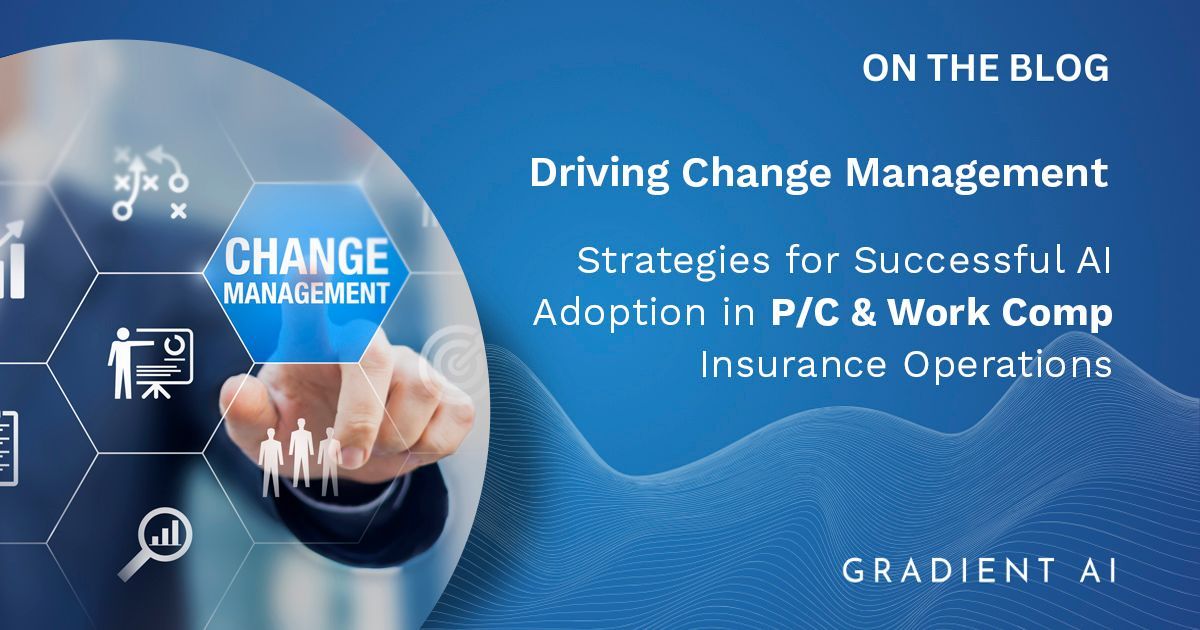Driving Change Management: Strategies for Successful AI Adoption in P/C and Work Comp Insurance Operations
In the P&C and workers’ comp insurance industries, AI's ability to analyze vast data sets to evaluate risk is a game-changer. It enables insurers to price policies more accurately, reduce quote turnaround times, triage claims, and reduce the duration and cost of claims. However, the transition from traditional methods to digital processes isn't always smooth. In this blog, we’ll explore the challenges of implementing AI solutions, and propose change management best practices, with a focus on how to overcome resistance to change with a change agent.
Challenges Faced by Insurance Companies Considering AI Adoption
- "We've always done it this way."
- "It will never work."
- "What a waste of money. Just another project that will fail."
- "Great, now I'll just have more work to do."
These are a few of the things we’ve heard customers say when they first start to work with AI and machine learning models. While many insurance companies are looking to embrace improved efficiency and growth, they face significant challenges that lead to resistance to adopting AI and automation solutions. Other industries seem to have embraced digital transformation more easily, however, the insurance industry still lags due to various factors. Here are a few reasons why:
- Business Models: Many insurers delay their digital adoption due to existing business models that require major restructuring to align new goals and flexibility.
- Scattered Data: Insurers often struggle with assimilating and analyzing vast amounts of unstructured and scattered data. This data management problem can be problematic when attempting automate.
- Fear and Uncertainty: Often, employees fear that AI will either micromanage them or take their jobs away, leading to resistance to change.
To address these challenges effectively and implement change management efficiently, companies may want to consider partnering with a company like Gradient AI, which specializes in AI solutions for the
P&C and
work comp insurance industries and has an
experienced change management team to facilitate seamless adaptation.
Best Change Management Strategies for Overcoming Resistance
Change Management is an ART - NOT a science. How we introduce changes can make or break our efforts. We can’t just send an email to announce the change and hope for the best. We need to be mindful of how people react to change.
Before you begin the process, consider completing a change readiness assessment to evaluate your organization’s readiness for change. It’s also important to understand the impacts of the change upstream and downstream as well as identify the key stakeholders and their roles.
A recent Prosci study found that 88% of companies with excellent change management programs exceeded expectations, compared to only 13% of those with poor change management programs.
The process of driving change through AI and automation in insurance processes requires transparent communication and support. This is why a change management program accompanied by a change liaison or change agent is necessary to achieve desired outcomes.
The Role of Change Agents in Insurance: Best Practice for Change Management
Change agents should:
- Integrate change plan activities into the project plan by attending workstream planning sessions, identifying necessary activities, and helping everyone stay on schedule.
- Identify change impacts on people, processes, and technology. For example, they will analyze current and future states and address concerns such as AI training needs and resource requirements.
- Plan and support engagement and communication by sending relevant communications to insurance stakeholders at the appropriate times. They will actively demonstrate support for the change outlined in the communication plan.
- Identify risks during workstream planning and create mitigation plans to reduce resistance to change. They will address risks such as potential employee turnover and develop plans to mitigate them.
- Lead by example, embodying the change they wish to see. They will create a unified message of change, remove obstacles, and display an unbiased attitude while welcoming feedback, emphasizing leadership and innovation in the insurance industry.
Modernizing your insurance business is not just about adopting new technologies; it's about embracing change and innovating for the future. By overcoming resistance through effective change management strategies, including communication, engagement, and clear expectations, insurance companies can unlock the full potential of AI and automation. Partner with Gradient AI for help with your change management goals as you transition to AI and automation solutions. We want to help you see your AI projects through to success!


